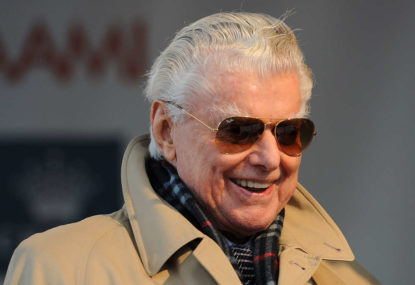TWO GOOD! Zahra wins back-to-back Melbourne Cups on Without a Fight as three horses pull up lame
Without a Fight completed the rare Caulfield Cup-Melbourne Cup double on Tuesday as star jockey Mark Zahra went back-to-back in the big one after…

Since Bart Cummings passed away, there has been a lot written in the press about what was the secret to his success.
Malcolm Knox opined that Bart’s secret was that he was just a “normal” bloke.
Those who have ‘done their time’ in the stables around Randwick racecourse over the last 50 years would know that Bart was indeed just a normal bloke, with all the strengths and failings that normal blokes have.
But the real key to understanding his success can be found in the way he trained his horses.
It is a truism that organisations, big and small, ultimately take on the character of the man at the top and, strangely enough, this also applies to trainers and their four-legged charges.
Bart was a laconic, laid-back character, and his training scheme actively promoted the same behaviour trait in his horses. He knew that to produce successful racehorses they had to learn to relax, and this was especially evident in the area he most excelled in, the training of stayers.
It was accomplished by training his horses a little bit slower, over a little bit further. Instead of doing most of their pacework at 3/4 pace (14 seconds to the furlong), his horses would work one second slower per furlong (known as ‘even pace’), and one furlong further. On gallop mornings they would work at even pace, then come home the last two or three furlongs on the bit (rather than pushed out), so that they learnt to relax.
Typical among this was Kingston Rule who, prior to winning the Melbourne Cup in 1990, did almost all his pacework in even time (15 seconds to the furlong), with his first recorded gallop of that campaign being three furlongs (a furlong equals 200 metres) at even pace, at Flemington in July.
By his second start in that preparation, a 1400-metre race, he was working at even time over six furlongs. By his fourth start, in September over 2100 metres, he was working eight furlongs at even time. Prior to the Mooney Valley Cup, which he won, he was working over 10 furlongs (2000m) at even time, as usual coming home the last two or three furlongs on the bit on gallop mornings.
Kingston Rule continued to work over 10 furlongs at even time prior to the Dalgety Handicap, in which he ran second, coming from 11th on the turn without being hit with the whip. On the Monday two days later, he worked an unknown amount, but it was thought to be 10 furlongs at even time. The next day he joined the long list of Cummings horses that have won the Melbourne Cup.
Training based around the relaxed pace of even time was the real key to Cummings’ success. Of course, many others have copied him, often very successfully. Included among these are his son and grandson, as well as quite a few trainers who had previously worked as one of his foremen, and Lee Freedman, who during his acceptance speech after training the quinella in the Melbourne Cup of 1989, thanked Cummings and admitted that he had copied his training.
It could be said that the beauty of Bart’s training was in its kindness. He produced laid-back horses, with the temperament to enjoy a productive retirement in a role such as leisure ponies or police horses. In a way, they were just like him.